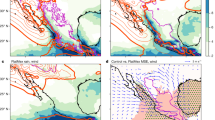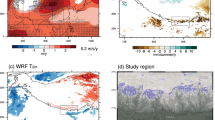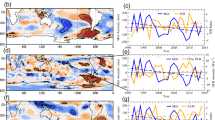Abstract
The monsoon depressions intensify over the Bay of Bengal, move in a west-north-west (WNW) direction and dissipate over the Indian continent. No convincing physical explanation for their observed movement has so far been arrived at, but here, I suggest why the maximum precipitation occurs in the western sector of the depression and propose a feedback mechanism for the WNW movement of the depressions. We assume that a heat source is created over the Bay of Bengal due to organization of cumulus convection by the initial instability. In a linear sense, heating at this latitude (20° N), produces an atmospheric response mainly in the form of a stationary Rossby–gravity wave to the west of the heat source. The low-level vorticity (hence the frictional convergence) and the vertical velocity associated with the steady-state response is such that the maximum moisture convergence (and precipitation) is expected to occur in the WNW sector at a later time. Thus, the heat source moves to the WNW sector at a later time and the feedback continues resulting in the WNW movement of the depressions.
This is a preview of subscription content, access via your institution
Access options
Subscribe to this journal
Receive 51 print issues and online access
$199.00 per year
only $3.90 per issue
Buy this article
- Purchase on Springer Link
- Instant access to full article PDF
Prices may be subject to local taxes which are calculated during checkout
Similar content being viewed by others
References
Saha, K., Sanders, F. & Shukla, J. Mon. Weath. Rev. 109, 330–345 (1981).
Koteswaram, P. & George, C. A. Indian J. Met. Geophys. 9, 9–22 (1958).
Koteswaram, P. & Bhaskar Rao, N. S. Aust. Met. Mag. 41, 62–75 (1963).
Rao, K. V. & Rajamani, S. Indian J. Met. Geophys. 21, 187–194 (1970).
Shukla, J. J. atmos. Sci. 35, 495–508 (1978).
Goswami, B. N., Keshavamurty, R. N. & Satyam, V. Proc. Indian Acad. Sci. (Earth. planet. Sci.) 89, 79–97 (1980).
Mishra, S. K. & Salvekar, P. S. J. atmos. Sci. 37, 383–394 (1980).
Lindzen, R. S., Farrell, B. & Rosenthal, A. J. J. atmos. Sci. 40, 1178–1184 (1983).
Moorthi, S. & Arakawa, A. J. atmos. Sci. 42, 2007–2031 (1985).
Krishnamurti, T. N. et al. J. met. Soc. Japan 54, 208–224 (1976).
Krishnamurti, T. N. Adv. Geophys. 28B, 283–333 (1985).
Krishnamurti, T. N., Molinari, J., Pang, H. L. & Wong, V. Pure appl. Geophys. 115, 1357–1372 (1977).
Gill, A. E.Q. Jl R. met. Soc. 106, 447–462 (1980).
Heckley, W. A. & Gill, A. E. Q. Jl R. Met. Soc. 110, 203–217 (1984).
Chang, C. P. J. atmos. Sci. 34, 901–910 (1977).
Geisler, J. E. & Stevens, D. E. Q. Jl R. Mel. Soc. 108, 87–93 (1982).
Yanai, M., Esbensen, S. & Chu, J. H. J. atmos. Sci. 30, 611–627 (1973).
Godbole, R. V. Tellus 29, 25–40 (1977).
Daggupaty, S. M. & Sikka, D. R. J. atmos. Sci. 33, 773–792 (1977).
Author information
Authors and Affiliations
Rights and permissions
About this article
Cite this article
Goswami, B. A mechanism for the west-north-west movement of monsoon depressions. Nature 326, 376–378 (1987). https://doi.org/10.1038/326376a0
Received:
Accepted:
Issue Date:
DOI: https://doi.org/10.1038/326376a0
This article is cited by
-
Possible zonal asymmetry of the Indian summer monsoon rainfall after ~5 ka BP as revealed by palaeo-salinity in the eastern Arabian Sea
Journal of Earth System Science (2022)
-
Combined signatures of atmospheric drivers, soil moisture, and moisture source on floods in Narmada River basin, India
Climate Dynamics (2022)
-
Understanding the role of cloud microphysical processes behind the Indian summer monsoon rainfall
Theoretical and Applied Climatology (2022)
-
Characteristics of the monsoon low pressure systems in the Indian subcontinent and the associated extreme precipitation events
Climate Dynamics (2021)
-
Closing the sea surface mixed layer temperature budget from in situ observations alone: Operation Advection during BoBBLE
Scientific Reports (2020)
Comments
By submitting a comment you agree to abide by our Terms and Community Guidelines. If you find something abusive or that does not comply with our terms or guidelines please flag it as inappropriate.



